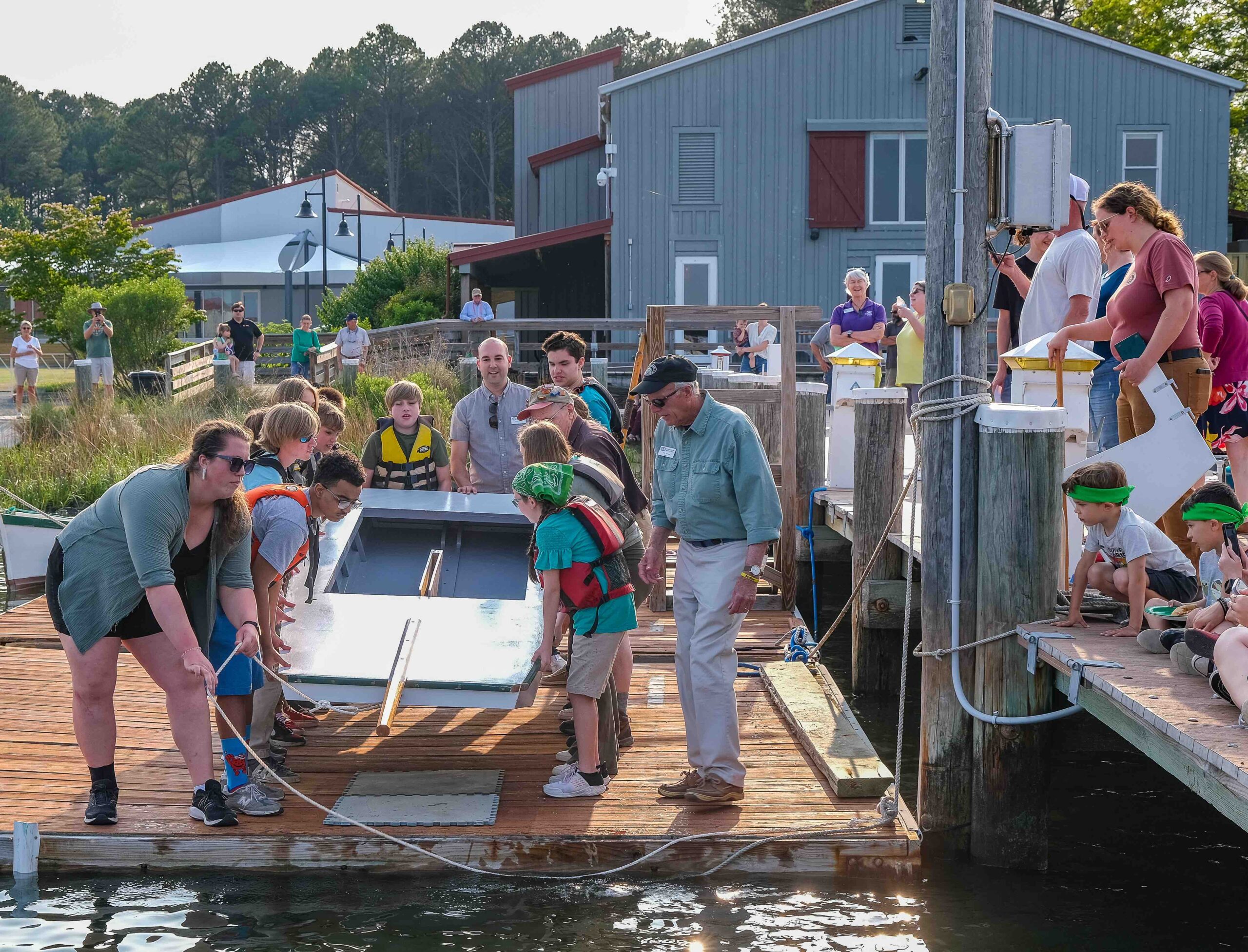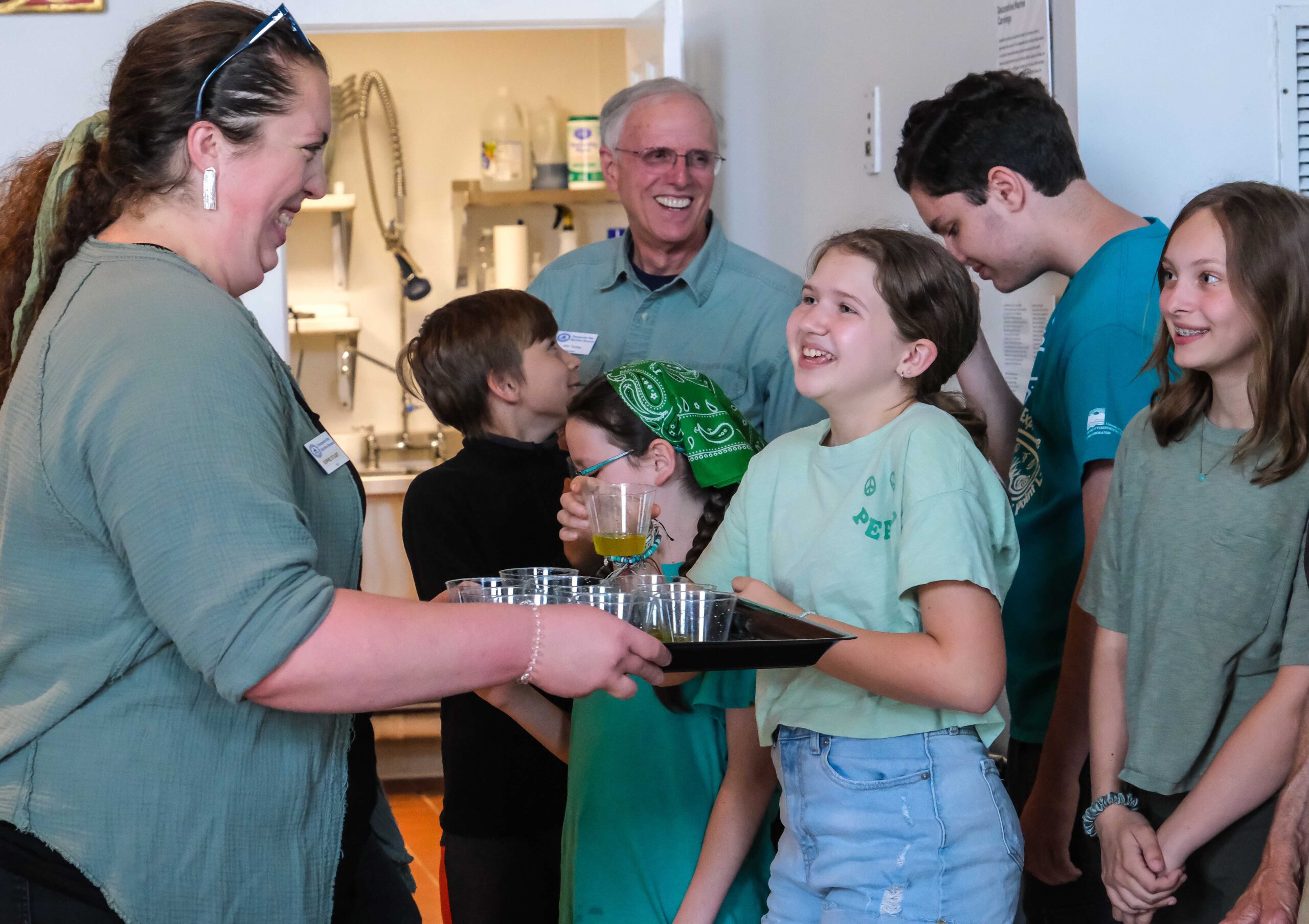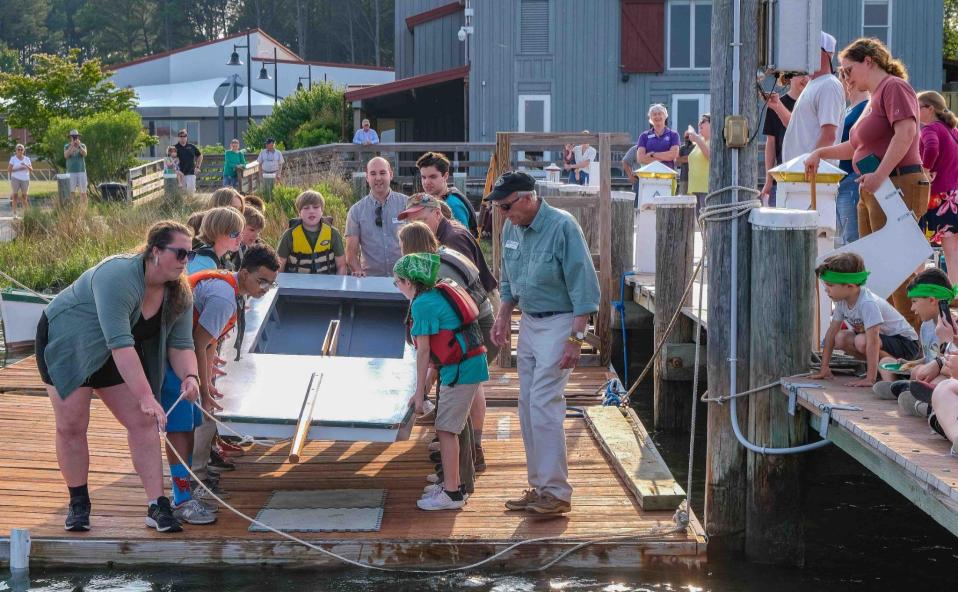With a collective push, a group of middle school students from the Chesapeake Bay Maritime Museum’s Rising Tide after-school program trundled the St. Michaels sailing scow they’ve spent the spring constructing onto the water for the first time on Monday evening.
The 12-foot wooden boat, dubbed Pickle by a consensus vote of the builders, launched into Fogg’s Cove to spirited cheers from the assembled group of family, friends and program supporters.
“It’s fun because you get to see all the stuff that you worked on, and then it’s finally done,” said seventh-grader Sofia Mercado, after taking her turn to get a short ride in the boat. “It’s fun to make something and see it turn out well.”
 Monday’s launch event, including an awards presentation and pickle juice toast, was a well-deserved celebration of months of hard work on the project.
Monday’s launch event, including an awards presentation and pickle juice toast, was a well-deserved celebration of months of hard work on the project.
Meeting on Mondays, Tuesdays, and Thursdays, a total of 19 middle school students logged a combined 630 hours toward the project this spring, following Shipwright Apprentice Megan Mitchell’s project plan with support from CBMM education staff and volunteers.
The scow build capped a busy and productive school year for Rising Tide, a free, donor-funded after-school program that has been teaching students in grades 6-9 basic boatbuilding and woodworking skills in a welcoming, relaxed environment since 2015.
“It’s been an incredible experience to see the Rising Tide participants take ownership of this project over the last few months,” CBMM Education Programs Manager Kendall Wallace said. “I hope this project will help to reinforce the ideas that anything is possible if you’re willing to try, and that patience and commitment can result in something to be incredibly proud of.
“I’m constantly inspired by the work they’ve put into this boat, which they can forever point to and say, ‘I built that.’”
Beginning in January, the Rising Tide students contributed to nearly every step in the process to bring the boat to life in the program workshop.
The project started by studying original plans in CBMM’s collection, drafted in 1929 for the Miles River Yacht Club by George Krill, to draw information about the boat’s shape and size and making a building plan for the molds to set the vessel’s structure.
Once construction commenced, the task list included assisting with milling lumber, scarfing planks, and transferring patterns from the lofting to the building stock. They were involved with the gluing up and shaping the mast and boom, crafting and installing all of the components, and painting the vessel, as well.
Each day brought new lessons for the students, ranging from wood species selection to proper use of block planes to the fine art of varnishing. One memorable February afternoon brought a field trip to the newly renovated Norman & Ellen Plummer Center for Museum Collections to examine a sail in the CBMM collection that was originally built for a St. Michaels scow.
The result was Pickle, which sparkled in the evening sun on Monday with its bright-white hull and green trim. It was the first boat built by the program since launching a pair of Chesapeake crab skiffs, Mary and Susan, in 2018.
Eighth-grader Mac Hudson said his favorite parts were learning the history of the boat and using a hand plane to shape it, while his brother Oskar, a sixth grader, liked getting to visit CBMM’s working Shipyard and the teamwork necessary to get the boat completed.
“We all worked together,” Mac Hudson said. “It’s cool that we got to help make it, and now it’s an actual boat that we can take on the water.”
For Mitchell, the build served as a capstone project of sorts in her final year of CBMM’s Shipwright Apprentice Program. She agreed to take on the project in December and quickly found it a mix of fun and challenging.
“We’ve learned a lot from the project about what is necessary to complete a project like this with a build philosophy that the kids are helping in a meaningful way,” Mitchell said. “That’s so important. We want them to be involved. If they’re just occasionally rubbing sandpaper on the boat, that’s not meaningful and that’s not building skills for them.”
Beyond the chance to teach her craft to the next generation, Mitchell found it meaningful to take a step back in time to complete a classic design with a distinctly local history.
True to its name, the scow is a St. Michaels original, serving as the racing class of the Miles River Yacht Club in the 1920s and ’30s. One of the few surviving examples is in CBMM’s collection and will be featured in the new watercraft heritage exhibition in the new Welcome Center.
This is likely the first one to be built in town in decades.
“It has been very a cool project to be a part of,” Mitchell said. “The Chesapeake produces a lot of very strange styles of boat that are easily replaced by mass-produced, more-generalized designs, but sometimes having this specific design for this very specific place is an extremely valuable thing.”
“It’s one of the things I love most about CBMM and its programs. Here, we don’t shy away from that specificity.”
Monday’s launch marked the end of spring programming but certainly not the workshop fun for the students involved. Many of them will take part in CBMM’s Summer Camp in the coming weeks, and Rising Tide will resume in the fall with a new, yet-to-be-determined project to tackle.
 Wallace is eager to make sure it’s something that will allow the students to build on the hands-on skills that they’ve practiced this spring and the camaraderie the group developed along the way.
Wallace is eager to make sure it’s something that will allow the students to build on the hands-on skills that they’ve practiced this spring and the camaraderie the group developed along the way.
“I don’t want you to forget the less technical skills that we practiced every day,” Wallace told the assembled group Monday. “We worked as a team, we practiced patience and understanding, we faced our mistakes when we made them, and we figured out how to do something that I don’t think any of us had ever done before.”
For more information on CBMM’s Rising Tide program, visit cbmm.org/youtheducation or email [email protected].



Write a Letter to the Editor on this Article
We encourage readers to offer their point of view on this article by submitting the following form. Editing is sometimes necessary and is done at the discretion of the editorial staff.